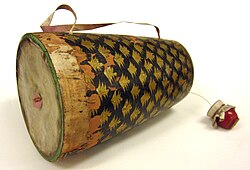Anandalahari
 | |
| Other names | gubgubi, khamak |
|---|---|
| Classification |
Chordophone |
| Hornbostel–Sachs classification | 22 (barrel shaped body, open on one side, and fixed on the bottom of a string(s)) |
| Related instruments | |
| Pullavan Kudam, Bhapang, gubgubi, Khamak | |
The anandalahari (
Name
The name anandalahari means "waves of joy". Popularly this instrument is called by
Description
The anandalahari has a barrel-shaped body, open on one side, and fixed on the "bottom" of a single string.[3][1] The tool body is wooden, open on both sides; the membrane is fixed in the lower and upper parts with a leather hoop and cords.[2] Some instruments have a hole in the upper diaphragm, others not; it may be completely absent in old instruments.[2] The vein string is attached to the bottom with a piece of bamboo or other material.[2] The other end of the string is fixed inside a copper pot.[2]
Use
The barrel is placed in the left armpit, the pot is taken in the left hand and the string is pulled with it, and the string is played with the right hand using a plectrum.[2]
A similar instrument named pulluvan kudam
Classification
See also
References
- ^ ISBN 978-1-351-54438-2.
- ^ .
- ISBN 978-90-04-32471-8.
- ISBN 9780883862612.
- ISBN 978-81-7099-881-5.
- ISBN 9783112132302.
- ^ L.E.R. Picken (1981): The 'Plucked Drums': Gopīyantra and Ānandalaharī’, Musica asiatica, iii, p 29–33
External links
- Anandalahari Banglapedia
